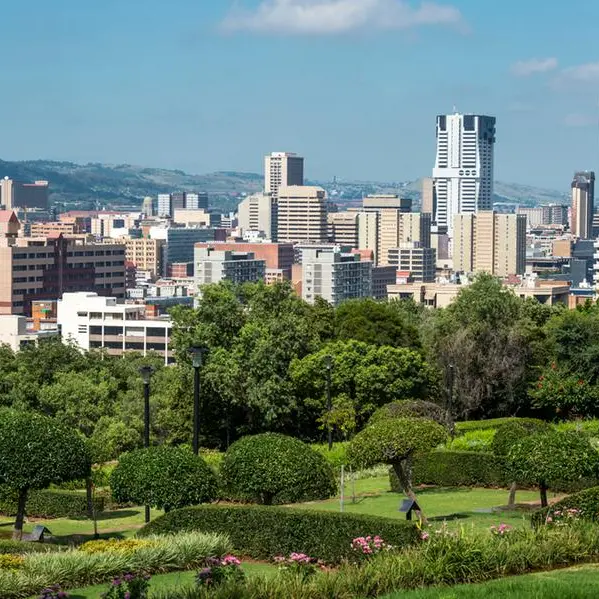PHOTO
Johannesburg cityscape, taken at sunset, showing Hillbrow residential centre with the prominent Ponte flats and the communications tower. Getty Images Image used for illustrative purpose
During the World Leaders’ Summit at COP 27 in November 2022, South African President Cyril Ramaphosa launched the new Just Energy Transition Investment Plan (JET IP) for South Africa. It was at COP 26 in November 2021, that it was first announced that the governments of France, Germany, the United Kingdom, the United States and the European Union had pledged USD 8.5 billion in first round financing to assist South Africa with energy transition projects as part of the Just Energy Transition Partnership (JETP) between the countries. In October 2022, the South African cabinet approved a five-year investment plan for the USD 8.5 billion package.
The Just Energy Transition Investment Plan (JET IP)
The JET IP is aligned with the Cabinet-approved National Just Transition Framework. The South African government said the plan outlined the investments required to achieve the country’s decarbonization commitments, while promoting sustainable development, and ensuring a just transition for affected workers and communities – in other words, a whole society approach.
The JET IP covers electricity, new energy vehicles (NEVs) and green hydrogen and identifies USD 98 billion in financial requirements over the next five years, to come from both the public and private sectors. The goal of the JET IP is to decarbonize the South African economy to within the NDC target range of 350-420 MtCO2 by 2030, in a just manner. The JET IP is centered on decarbonization, social justice, economic growth and inclusivity, and governance. The investment criteria for the Plan include projects that deliver on greenhouse gas emissions reduction and just transition outcomes, and are catalytic in nature and ready to implement.
Key investments under the JET IP will include:
- Electricity – Decommissioning (repowering and repurposing with clean technologies), transmitter grid strengthening and expansion, and renewable energy.
- New Energy Vehicles – Decarbonizing the automotive sector and supporting supply chain transition towards green sustainable manufacturing.
- Gaseous Hydrogen (GH2) – Essential planning and feasibilities including port investment to enhance exports and boost employment and GDP.
- Cross-cutting – Investment in skills development and municipalities.
Also at COP 27, Masopha Moshoeshoe, a green economy specialist in the Presidency’s Investment and Infrastructure Office, said that the country was seeking to attract investment worth USD 250 billion for the development of its green hydrogen energy economy by 2050. Moshoeshoe said the industry could create around 1.4 million jobs and USD 30 billion in annual revenue by 2050, but that renewable-power generation capacity of between 140,000 MW and 300,000 MW was needed to supply the green hydrogen sector. The country currently has renewable energy capacity of around 40,000 MW.
Just transition
In South Africa, there is a requirement to build economic and social resilience to meet the NDC targets, and to manage transition risks and ensure social preparedness as the country diversifies its energy mix and grows new industries. A just transition takes into account the requirement to balance the reduction of carbon emissions with the impact of this transition on employment and the need to develop long-term green energy jobs, especially in respect of impacted communities that have a current heavy reliance on fossil fuels. There is also a need to recognize location and sector-specific vulnerabilities (such as care, preparation and social infrastructure) and intergenerational effects.
Coal remains the primary source of energy for the country, but in order for South Africa to reach its reduction in carbon emission targets, this must change. Reskilling the existing workforce and educating the future workforce is also essential. South Africa updated its NDC under the Paris Agreement in 2021 and now has a proposed revised target range of 398 to 510 Mt CO2-eq for 2025, and 398 to 440 Mt CO2-eq for 2030.
Policy developments
There have been a number of policy developments to assist South Africa with its energy transition. The National Development Plan (NDP), the draft Integrated Energy Plan (IEP), the Renewable Energy White Paper, the Nationally Determined Contribution (NDC), the Just Transition Framework, and enabling policies under development and in implementation, outline the policy foundation for energy transition in South Africa and the move away from carbon-fuelled energy. The Integrated Resource Plan (IRP) 2019 covers the government’s plans for power until 2030 and outlines a decreased reliance on coal-powered energy and an increased focus on a diversified energy mix that includes renewable energy, distributed generation and battery storage.
The Renewable Energy Independent Power Producer Procurement Program (REIPPPP), introduced in 2011, outlined the procurement of renewable energy in the country. The sixth round of the REIPPP kicked off in 2022 and this round aims to procure 2.6 GW of solar and wind power. To incentivize the self-generation of renewable energy, the South African government has also indicated that it proposes to scrap the threshold for distributed energy generation of 100 MW, meaning that large-scale power plants in excess of 100 MW could be built without a license, to meet their own demand and to sell to the grid. Other developments include, inter alia, the South African Automotive Master Plan, the Climate Change Bill, the South Africa Green Taxonomy and carbon tax increases. Further policies such as the National Energy Efficiency Strategy and the Green Transport Strategy also have a role to play in ensuring the country meets its climate change targets and reduces its carbon emissions.
Trading in carbon offsets in the carbon market, where companies can pay other entities to offset their emissions for them, is also growing in popularity in emerging markets. In August 2022, the Johannesburg Stock Exchange announced that it was investigating the possibility of introducing a carbon trading market in South Africa.
In February 2022, the South African Hydrogen Society Roadmap (HSRM) was published by the South African government. The Roadmap is considered to be an important marker on its path towards implementing hydrogen development, which is envisaged to be at the centre of South Africa’s strategy for economic growth and mitigating climate change.
As part of a diversified energy mix strategy, Eskom also recently identified eighteen independent power producer bids in terms of an auction relating to the use of vacant land it owned in Mpumalanga, situated in proximity to its coal-fired power stations, with direct access to the national transmission network that will enable wheeling. The projects will add approximately 1,800 MW of renewable power to the South African grid.
Further, recent amendments to the Electricity Regulation Act were proposed by the Department of Minerals Resources and Energy and are likely to address, inter alia, the electricity supply deficit, the vertical structure of the market and the lack of competition, the introduction of a multi-market including independent power producers (IPPs), and the formation of a central purchasing agency. The amendments will also address the introduction of a day-ahead market to accommodate hourly supply and demand, the direct procurement of power by municipalities, the increase in the threshold pertaining to self-generation, the need to accommodate low carbon-emitting generation technologies, the timing of licensing applications, changes in transmission system operation including power trading, and the creation of additional regulatory capability. The strategy aims to accelerate affordable, decentralized, diversely owned renewable energy systems.
The lack of access to affordable and secure power has had a significant impact on the private sector in South Africa for some time, and the country’s energy policy developments, which are aligned with the global energy transition towards a clean and decentralized energy system, have been welcomed as a means to improve access to decarbonized, affordable renewable energy that takes into account the country’s carbon reduction commitments and economic growth requirements based on a just transition.
Copyright © 2022 AfricaBusiness.com - All materials can be used freely, indicating the origin AfricaBusiness.com Provided by SyndiGate Media Inc. (Syndigate.info).























